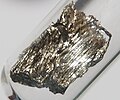Lanthanide
Lanthanide
The lanthanides, also known as the lanthanoids, are a series of chemical elements in the periodic table with atomic numbers from 57 to 71, from lanthanum through to lutetium. These elements, along with scandium and yttrium, are often collectively known as the rare earth elements.
Properties[edit]
Lanthanides are characterized by their high atomic and ionic sizes, and they exhibit a +3 oxidation state in most of their compounds. They are known for their magnetic, catalytic, and luminescent properties, which make them valuable in various technological applications.
Physical Properties[edit]
Lanthanides are typically silvery-white metals that are soft and malleable. They have high melting and boiling points, and they are good conductors of electricity. The lanthanides are known for their ability to form alloys with other metals, enhancing the properties of the base metal.
Chemical Properties[edit]
The lanthanides are highly reactive, especially when finely divided or in the presence of moisture. They readily oxidize in air, forming a tarnish. The reactivity of lanthanides increases with atomic number, and they can react with water to form hydroxides and hydrogen gas.
Applications[edit]
Lanthanides have a wide range of applications due to their unique properties. They are used in the production of strong permanent magnets, phosphors for color television tubes and LED lights, catalysts in petroleum refining, and in various other high-tech applications.
Magnets[edit]
Neodymium, a lanthanide, is used to make powerful permanent magnets, which are essential components in many electronic devices, including hard drives, wind turbines, and electric vehicle motors.
Phosphors[edit]
Lanthanides such as europium and terbium are used in phosphors that emit red and green light, respectively. These phosphors are crucial in the manufacturing of color displays and LED lighting.
Catalysts[edit]
Lanthanides are used as catalysts in various industrial processes, including the cracking of crude oil in petroleum refineries. Cerium, in particular, is used in catalytic converters to reduce emissions from vehicles.
Biological Role[edit]
Lanthanides have no known biological role in humans, but they are used in some medical applications. For example, gadolinium is used as a contrast agent in magnetic resonance imaging (MRI) due to its paramagnetic properties.
Environmental Impact[edit]
The mining and processing of lanthanides can have significant environmental impacts, including habitat destruction and pollution. Efforts are being made to develop more sustainable methods of extraction and recycling of these elements.
See Also[edit]
External Links[edit]
- [Lanthanide Series on Wikipedia](https://en.wikipedia.org/wiki/Lanthanide)
| Branches of chemistry | ||||||||||
|---|---|---|---|---|---|---|---|---|---|---|
|
Lanthanide[edit]
-
Lanthanum
-
Cerium
-
Praseodymium
-
Neodymium
-
Promethium
-
Samarium
-
Europium
-
Gadolinium
-
Terbium
-
Dysprosium
-
Holmium
-
Erbium
Ad. Transform your life with W8MD's Budget GLP-1 injections from $75


W8MD offers a medical weight loss program to lose weight in Philadelphia. Our physician-supervised medical weight loss provides:
- Weight loss injections in NYC (generic and brand names):
- Zepbound / Mounjaro, Wegovy / Ozempic, Saxenda
- Most insurances accepted or discounted self-pay rates. We will obtain insurance prior authorizations if needed.
- Generic GLP1 weight loss injections from $75 for the starting dose.
- Also offer prescription weight loss medications including Phentermine, Qsymia, Diethylpropion, Contrave etc.
NYC weight loss doctor appointmentsNYC weight loss doctor appointments
Start your NYC weight loss journey today at our NYC medical weight loss and Philadelphia medical weight loss clinics.
- Call 718-946-5500 to lose weight in NYC or for medical weight loss in Philadelphia 215-676-2334.
- Tags:NYC medical weight loss, Philadelphia lose weight Zepbound NYC, Budget GLP1 weight loss injections, Wegovy Philadelphia, Wegovy NYC, Philadelphia medical weight loss, Brookly weight loss and Wegovy NYC
|
WikiMD's Wellness Encyclopedia |
| Let Food Be Thy Medicine Medicine Thy Food - Hippocrates |
Medical Disclaimer: WikiMD is not a substitute for professional medical advice. The information on WikiMD is provided as an information resource only, may be incorrect, outdated or misleading, and is not to be used or relied on for any diagnostic or treatment purposes. Please consult your health care provider before making any healthcare decisions or for guidance about a specific medical condition. WikiMD expressly disclaims responsibility, and shall have no liability, for any damages, loss, injury, or liability whatsoever suffered as a result of your reliance on the information contained in this site. By visiting this site you agree to the foregoing terms and conditions, which may from time to time be changed or supplemented by WikiMD. If you do not agree to the foregoing terms and conditions, you should not enter or use this site. See full disclaimer.
Credits:Most images are courtesy of Wikimedia commons, and templates, categories Wikipedia, licensed under CC BY SA or similar.
Translate this page: - East Asian
中文,
日本,
한국어,
South Asian
हिन्दी,
தமிழ்,
తెలుగు,
Urdu,
ಕನ್ನಡ,
Southeast Asian
Indonesian,
Vietnamese,
Thai,
မြန်မာဘာသာ,
বাংলা
European
español,
Deutsch,
français,
Greek,
português do Brasil,
polski,
română,
русский,
Nederlands,
norsk,
svenska,
suomi,
Italian
Middle Eastern & African
عربى,
Turkish,
Persian,
Hebrew,
Afrikaans,
isiZulu,
Kiswahili,
Other
Bulgarian,
Hungarian,
Czech,
Swedish,
മലയാളം,
मराठी,
ਪੰਜਾਬੀ,
ગુજરાતી,
Portuguese,
Ukrainian











